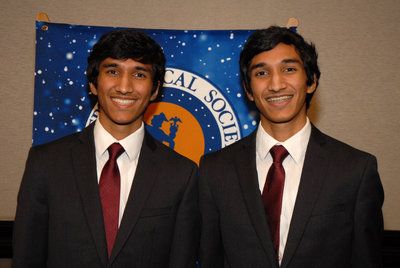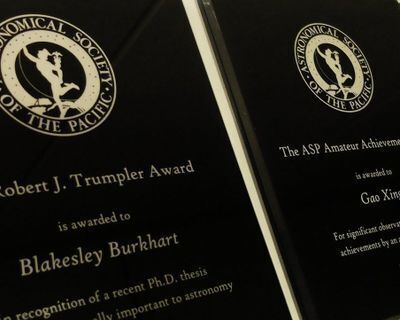Priscilla and Bart Bok Award
The Bok prize is named for Bart and Priscilla Bok. Bart Bok was an outstanding research astronomer who made important contributions to our understanding of the Milky Way and of star formation. He received the Bruce Medal for lifetime achievement in astronomy, and in 1982 the Klumpke-Roberts Award for the popularization of astronomy. Throughout his life, and especially as an ASP Board member, Bok was a strong advocate for outreach and education in astronomy as was his wife, Priscilla, also a distinguished astronomer. Upon Bart Bok’s death in 1983, the Society established the Bart Bok Memorial Fund to support educational projects. At the suggestion of the AAS, the activities supported by the Bok Fund were expanded to include the joint sponsorship of an astronomy Priscilla and Bart Bok Award given at the Intel Science and Engineering Fair. The Priscilla and Bart Bok Award was last given in 2017 and is no longer an existing Award.

Shashank Dholakia and Shishir Dholakia Recipients of the 2016 Bart Bok Award
The Priscilla and Bart Bok Awards were given jointly by the ASP and the AAS up through 2017. The main criterion for selecting the two annual Bok Award winners is scientific merit. Observational, instrumental, theoretical, and interdisciplinary projects involving physics, mathematics, computer sciences, and engineering in support of astronomy are eligible. The awarded funds are intended to be used by the recipients to further their education and research efforts, and are augmented by support for travel to the next winter meeting of the AAS.
First- and Second-prize Bok awardees listed for each year, as selected at the annual Intel International Science and Engineering Fair (ISEF). Supported by funds from the National Science Foundation (NSF) in a grant to the Astronomical Society of the Pacific (ASP) and the American Astronomical Society (AAS).
2017
Cormac Larkin, Colaiste an Spioraid Naoimh, Ireland
Case Study of Data Mining in Observational Astronomy: The Search for New OB Stars in the Small Magellanic Cloud
Erica Sawczynec, Kihei Public Charter High School, HI, United States of America
Determining the Ages and Distances of Open Clusters

